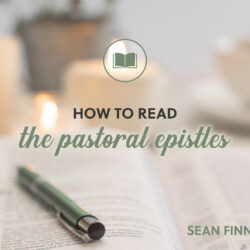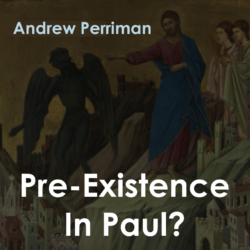This is part 15 of the Read the Bible For Yourself.
In previous episodes, we’ve looked at Paul’s church epistles and pastoral epistles. Today we move into the third section of epistles in the New Testament–the general epistles. Instead of surveying each of the eight general epistles, we’ll just focus on two: Hebrews and 1 John. We’ll ask about author, audience, occasion, purpose, and mode for each. Going through these two will hopefully provide you with helpful examples to enable you to read these epistles more fruitfully on your own.
Listen to this episode on Spotify or Apple Podcasts
—— Links ——
- See other episodes in Read the Bible For Yourself
- Other classes are available here, including How We Got the Bible, which explores the manuscript transmission and translation of the Bible
- Get the transcript of this episode
- Support Restitutio by donating here
- Join our Restitutio Facebook Group and follow Sean Finnegan on Twitter @RestitutioSF
- Leave a voice message via SpeakPipe with questions or comments and we may play them out on the air
- Intro music: Good Vibes by MBB Attribution-ShareAlike 3.0 Unported (CC BY-SA 3.0) Free Download / Stream: Music promoted by Audio Library.
- Who is Sean Finnegan? Read his bio here
—— Notes ——
The General Epistles
- Hebrews, James, 1 Peter, 2 Peter, 1 John, 2 John, 3 John, Jude
- Some consider Hebrews to be Pauline, but even if Paul wrote it, it’s not to a church or a pastor, so it still fits as a general epistle
- 2 John and 3 John are technical to specific individuals and thus not general epistles
Hebrews
- Authorship
- Evidence for Paul
- Associated with Timothy and Rome (Heb 13:23-24)
- Pauline themes
- Evidence against Paul
- Non-Pauline themes
- Ancient uncertainty (Origen, Eusebius, etc.)
- Non-standard opening
- Not an eyewitness (Heb 2:3)
- Daniel Wallace suggested Barnabas with help from Apollos.
- Evidence for Paul
- Audience
- As title indicates, the audience was Jewish.
- Persecuted (Heb 10:32-36)
- Occasion
- Became aware of some falling away from faith (Heb 3:6; 4:14; 6:4-6; 10:23, 26-27)
- Concern that they will return to Judaism
- Purpose
- Convince Jewish Christians to endure in the faith instead of falling away (presumably back into Judaism)
- Mode
- Show that Jesus is better
- Ch 1: Jesus as God’s promised Messiah is better than the angels who gave the Law.
- Ch 2: Jesus’ salvation is better b/c he is human.
- Ch 3: Jesus is better than Moses.
- Ch 7: Jesus’ priesthood is better than Aaron’s.
- Ch 8: Jesus’ covenant is better than the old covenant b/c it has better promises.
- Ch 9: Jesus’ heavenly priestly service is better than the priests serving at the temple on earth.
- Ch 10: Jesus’ sacrifice is better than animal sacrifices.
- Ch 11: The unshakable Mt. Zion covenant is better than the covenant at Mt. Sinai.
- Overall rhetorical effect to ask, “Why in the world would Christ-followers want to downgrade to Judaism after they’ve tasted something so much better?”
1 John
- Authorship
- No author in the document itself (1 John 1:1)
- Early Christians refer to this letter as written by John
- Irenaeus (a.d. 180) attributed the Gospel of John and 1 John to “John, the disciple of the Lord”[1]
- Later Christians agreed, including Tertullian, Clement of Alexandria, Origen, and the Muratorian Canon
- Eusebius says, “But of John’s writings, in addition to the Gospel, the first of the letters is unambiguously accepted [as genuine] both by people today and by the ancients” (H.E. 3.24.17)[2]
- Definitely the same John who wrote the Gospel of John (John the Apostle)
- Same vocabulary and writing style
- Audience
- Christians that John is worried about
- Occasion: concern over rogue Christians
- “They went out from us, but they did not belong to us”
(1 John 2:19). - They are trying to deceive the regular Christians (2:26; 3:7).
- Many false prophets have gone out (4:1).
- They are denying that Jesus is the Christ (2:22).
- They may have been teaching that sin is ok (3:7-10).
- “They went out from us, but they did not belong to us”
- Purpose
- Equip Christians to discern and resist false teachings
- Encourage them to
- Live righteously
- Believe correctly about Jesus
- Love one another
- Mode
- Christology
- “Confesses that Jesus Christ has come in the flesh” (4:2)
- “Testify that the Father has sent his son as the savior of the world” (4:14).
- “Confess that Jesus is the son of God” (4:15)
- “Believes that Jesus is the Christ” (5:1)
- “Believes that Jesus is the son of God” (5:5)
- “Believes in the son of God” (5:10)
- “Life is in his son” (5:11)
- “Believe in the name of the son of God” (5:13)
- Behavior (1 John 3:7-10)
- “It is unlikely that John has in mind absolute sinless perfection, since earlier he has denounced those who say they are without sin (1:8, 10). Rather, John has in mind the blatant sinning to which those who have left the community have fallen prey (2:19). In view of the letter as a whole, such sinning probably involves denial of Christ’s human nature (4:2-3; theological lapse), flaunting of God’s (or Christ’s) commands (2:4; ethical lapse), failure to love (4:20; relational lapse), or some combination of these grave errors.”[3]
- Many appeals to live righteously (1 John 1:.5-6; 2:1-6; 3:4-10, 23-24; 5:18)
- Live differently than the world (1 John 2:15-17; 3:1, 13; 4:4-6; 5:4-5, 19)
- Love your brother/sister in Christ (1 John 2:10-11; 3:11, 14-18; 4:7-12, 16-21; 5:1-3)
- Christology
Review
- General epistles are for Christians in general rather than a specific church or person.
- In order to understand the general epistles, it’s helpful to figure out authorship, audience, occasion, purpose, and mode.
- Authorship is explicit for James, 1 Peter, 2 Peter, and Jude, but takes some work to figure out for Hebrews and 1-3 John.
- Hebrews was probably not written by Paul but by someone who spent time with him like Priscilla, Luke, Barnabas, or Apollos.
- Audience and occasion are often intertwined and determinable by gleaning bits of historical information from the epistles themselves. As you read, ask yourself, “Who was the original audience?” and “What was going on with them?”
- To discern the purpose, ask, “What is the author’s main goal in this epistle?”
- Mode is answering the question, “How does the author go about achieving his purpose?”
- Once you’ve figured out the author, audience, occasion, purpose, and mode, understanding the rest of the epistle’s particulars is much easier.
[1] Irenaeus, Against Heresies 3.16.5, 8. ANF translation.
[2] Eusebius, 148.
[3] Yarbrough, Robert. “1 John” in Hebrews to Revelation, vol 4 of ZIBBCNT, ed. Clinton E. Arnold (Grand Rapids, MI: Zondervan, 2002), 176-212.







Hi Sean, I listened with interest on your take of 1John 3:9 and ‘he cannot sin’. We know from John 3:6 ‘That which is born of flesh is flesh, that which is born of spirit is spirit’. Is any of us spirit yet, or are we still flesh? This unambiguous definition of a new birth enables us to correctly understand 1John 3:9. At Jesus’ return the saints will be changed to spirit life – no longer flesh. They will be born again, no longer able (or willing) to sin – because they are filled with God’s seed as 1John 3:9 points out. When we allow the Bible to correctly interpret the difficult passages, the subject of born again (or from above) will become clearer and remove the need to explain away passages that don’t make sense at first like, ‘he cannot sin’.
Regarding the spirit in believers, at this point we only have a deposit and a ‘down-payment’ and are definitely not spirit. 2Cor 1:21- (pledge), 2Cor 5:5, Acts 2:38 (gift)
There are a lot of passages about ‘born again’ that need to be reconsidered in light of the clear and unambiguous ones. Especially with regard to the ‘now but not yet’ paradigm that the Bible contains much of.
Thanks again, excellent work restoring true understanding to those who can see. and hunger for!